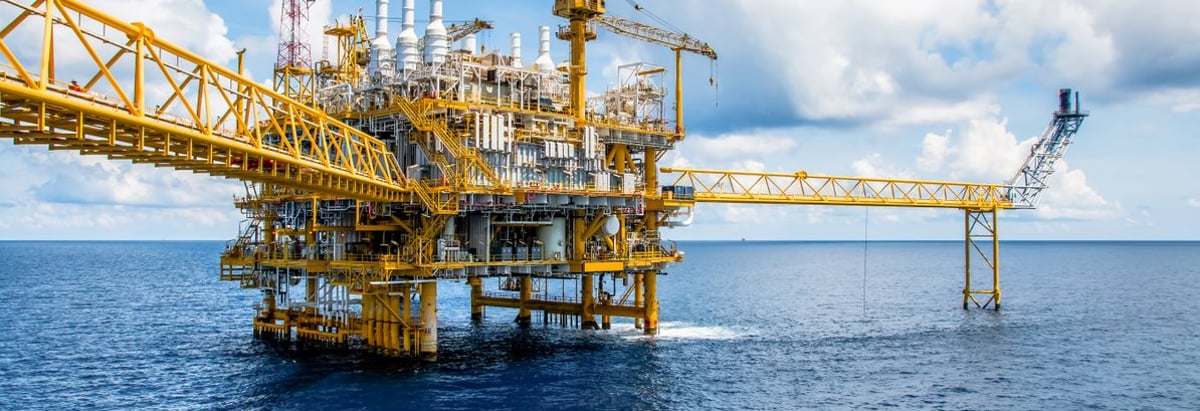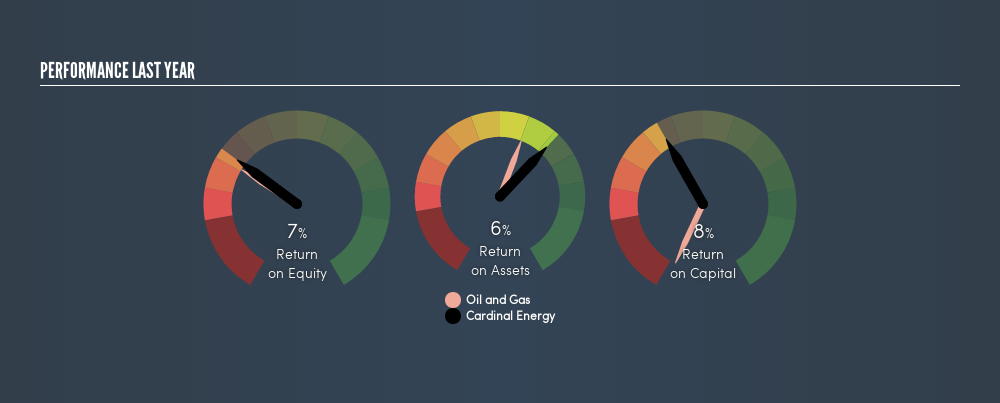- Canada
- /
- Oil and Gas
- /
- TSX:CJ
What Can We Make Of Cardinal Energy Ltd.’s (TSE:CJ) High Return On Capital?

Want to participate in a short research study? Help shape the future of investing tools and you could win a $250 gift card!
Today we are going to look at Cardinal Energy Ltd. (TSE:CJ) to see whether it might be an attractive investment prospect. Specifically, we'll consider its Return On Capital Employed (ROCE), since that will give us an insight into how efficiently the business can generate profits from the capital it requires.
First, we'll go over how we calculate ROCE. Second, we'll look at its ROCE compared to similar companies. And finally, we'll look at how its current liabilities are impacting its ROCE.
What is Return On Capital Employed (ROCE)?
ROCE is a metric for evaluating how much pre-tax income (in percentage terms) a company earns on the capital invested in its business. All else being equal, a better business will have a higher ROCE. Ultimately, it is a useful but imperfect metric. Renowned investment researcher Michael Mauboussin has suggested that a high ROCE can indicate that 'one dollar invested in the company generates value of more than one dollar'.
How Do You Calculate Return On Capital Employed?
The formula for calculating the return on capital employed is:
Return on Capital Employed = Earnings Before Interest and Tax (EBIT) ÷ (Total Assets - Current Liabilities)
Or for Cardinal Energy:
0.084 = CA$97m ÷ (CA$1.2b - CA$75m) (Based on the trailing twelve months to March 2019.)
Therefore, Cardinal Energy has an ROCE of 8.4%.
See our latest analysis for Cardinal Energy
Does Cardinal Energy Have A Good ROCE?
One way to assess ROCE is to compare similar companies. In our analysis, Cardinal Energy's ROCE is meaningfully higher than the 5.4% average in the Oil and Gas industry. We consider this a positive sign, because it suggests it uses capital more efficiently than similar companies. Separate from how Cardinal Energy stacks up against its industry, its ROCE in absolute terms is mediocre; relative to the returns on government bonds. Readers may find more attractive investment prospects elsewhere.
Cardinal Energy has an ROCE of 8.4%, but it didn't have an ROCE 3 years ago, since it was unprofitable. That implies the business has been improving.

When considering this metric, keep in mind that it is backwards looking, and not necessarily predictive. ROCE can be misleading for companies in cyclical industries, with returns looking impressive during the boom times, but very weak during the busts. This is because ROCE only looks at one year, instead of considering returns across a whole cycle. Remember that most companies like Cardinal Energy are cyclical businesses. Future performance is what matters, and you can see analyst predictions in our free report on analyst forecasts for the company.
Do Cardinal Energy's Current Liabilities Skew Its ROCE?
Current liabilities include invoices, such as supplier payments, short-term debt, or a tax bill, that need to be paid within 12 months. Due to the way the ROCE equation works, having large bills due in the near term can make it look as though a company has less capital employed, and thus a higher ROCE than usual. To counteract this, we check if a company has high current liabilities, relative to its total assets.
Cardinal Energy has total assets of CA$1.2b and current liabilities of CA$75m. As a result, its current liabilities are equal to approximately 6.1% of its total assets. Cardinal Energy has a low level of current liabilities, which have a minimal impact on its uninspiring ROCE.
What We Can Learn From Cardinal Energy's ROCE
Based on this information, Cardinal Energy appears to be a mediocre business. Of course, you might also be able to find a better stock than Cardinal Energy. So you may wish to see this free collection of other companies that have grown earnings strongly.
I will like Cardinal Energy better if I see some big insider buys. While we wait, check out this free list of growing companies with considerable, recent, insider buying.
We aim to bring you long-term focused research analysis driven by fundamental data. Note that our analysis may not factor in the latest price-sensitive company announcements or qualitative material.
If you spot an error that warrants correction, please contact the editor at editorial-team@simplywallst.com. This article by Simply Wall St is general in nature. It does not constitute a recommendation to buy or sell any stock, and does not take account of your objectives, or your financial situation. Simply Wall St has no position in the stocks mentioned. Thank you for reading.
About TSX:CJ
Cardinal Energy
Engages in the acquisition, exploration, development, optimization, and production of petroleum and natural gas in the provinces of Alberta, British Columbia, and Saskatchewan in Canada.
Good value with proven track record.
Market Insights
Community Narratives


